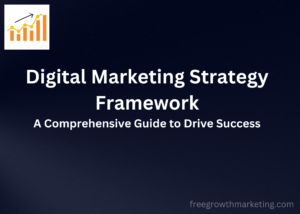Digital Marketing Strategy Framework: A Comprehensive Guide to Drive Success – Free Growth Marketing .Com
Introduction
A business needs to innovate today to overtake and keep the lead in this rapidly changing digital landscape that effective digital marketing can provide. It will give you a robust framework of a digital marketing strategy that helps to steer toward attaining sustainable growth, connection with your audience, and competitiveness. Here are the basic elements of a successful digital marketing strategy that will ensure your online presence flourishes.
Why Do You Need a Digital Marketing Strategy Framework?
A framework for a digital marketing strategy would be an organized road map so that all marketing effort is kept aligned with your business goals. Without a well-thought plan, marketing campaigns may flounder in a direction that wouldn’t find the return on investment needed. A well-crafted framework creates much-needed clarity and consistency and can generate measurable results.
Also Read: How to Choose the Best Growth Agency for Your Business
Core Elements of a Digital Marketing Strategy Framework
1. Audience Analysis and Persona Development
Know who your target audience is. Any effective digital marketing campaign starts with a good understanding of the audience. Therefore, continue to develop complex buyer personas from demographics, preferences, pain points, and buying behavior so that the more you know about your target audience, the more targeted and relevant will be your campaigns.

2. Identification of Marketing Objectives
Define SMART goals for your digital marketing campaigns. Common objectives are higher website traffic, more leads, brand awareness, and sales. Select those objectives which are more applicable to your business goals applying the SMART criteria: Specific, Measurable, Achievable, Relevant, and Time-bound.
3. Content Marketing Strategy
Build from well-defined content marketing strategy if to build trust, educate the audience, or drive engagement. Focus on quality, high-value content you have at hand to talk about that can speak to your audience: blog posts, videos, infographics, podcasts, and eBooks. Don’t forget proper SEO keywords in your content for maximum search visibility.
Also Read: What is A/B Testing? A Definitive Guide for Optimization of Your Conversion Rates
4. SEO Optimization
Proper use of SEO creates importance in ranking high on search engines like Google. Make use of the strategy by using on-page SEO and off-page SEO. It will have keyword research, meta tags optimization, backlink building, and more. It must have to be mobile-friendly and speedy. Thus it creates a very long organic traffic and can make better search engine rankings.
5. Social Media Marketing
Social media allows for a great opportunity to reach your audience and elevate your brand recognition. You can share valuable information, engage with followers, and keep doing so to market your products or services through Facebook, Instagram, Twitter, LinkedIn, or TikTok, and the list continues. Even organic together with some paid may increase the reach.
6. Email Marketing
Email marketing is one of the most cost-effective ways to feed your leads and to keep your current customers in touch. Keep separate, relevant email lists to forward targeted communications like sending product suggestions, special deals, etc. Automated sequences like welcome emails and cart abandonment reminders will lift conversion appreciably.
7. Pay-Per-Click Advertising (PPC)
PP Exposing high-converting audience : you must run paid ads on Google Ads, Facebook Ads, or LinkedIn Ads. Thus, your campaigns should be well optimized with the relevant keywords, good ad copy, and clear call to action in order to maximize return on investment. Checking regularly and readjusting campaigns with better outcomes is nothing bad about it.
8. Analytics and Reporting
Make your digital marketing strategy more data-driven. You will monitor key performance indicators, such as traffic, bounce rate, conversion rates, and ROI, using tools like Google Analytics, SEMrush, or HubSpot. Data analysis will tell you what’s working and what’s not, and the growth could be continuous.
Also Read: Top 10 Growth Marketing Courses in 2024 – Full Detail – Free Online & Offline Courses
How to Create an Effective Digital Marketing Strategy Framework:
Carry out your SWOT analysis to indicate key areas of business strengths, weaknesses, opportunities, and threats that will guide most of your marketing decisions.
Customer Journey Map: Describe all the steps your customer goes through from becoming aware of your product to actual conversion and thus align marketing efforts accordingly.
Identify and Engage Suitable Channels: Recognize which digital marketing channels will most help you reach your target audience. Whether it is by social media, SEO, email marketing, or any other, the options are endless.
Content calendar: content preparation beforehand. This will help ensure that all messaging on all channels is consistent and, of course, it’ll keep your audience engaged with continuously posting content.
Dribble out your digital marketing campaigns and track their performance regularly. Use available data as an adjustment point that will revise your strategy to have the best possible effect.
Also Read: What is Growth Hacking: The Ultimate Guide to Super-Fast Business Growth
Also Read: What is Growth Marketing? A Complete Guide to Driving Sustainable Business Growth
Conclusion
Hence, if there is a necessity to gain sustainable business success, then an apt digital marketing strategy framework needs to be created. This can be approached by targeting audience understanding, clear objectives, quality content, measurable analytics, and thus leading towards a dynamic and adaptive marketing strategy that triggers real effects. Keep following the trends, and your brand will flourish in this competitive digital landscape.

Pingback: Digital Marketing Benefits for Business: A Comprehensive Guide - Free Growth Marketing .Com - Free Growth Marketing .Com